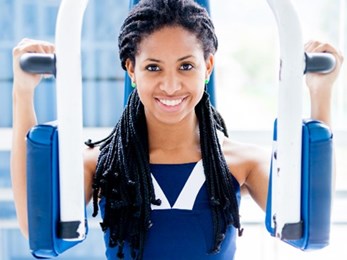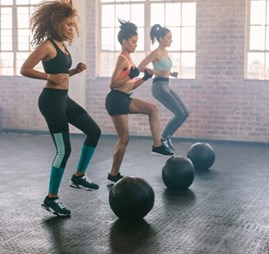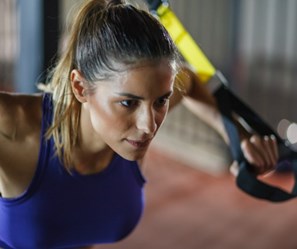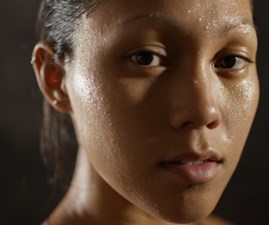 There is enough evidence to suggest that how active we are and the exercise we do, can show on our faces.
There is enough evidence to suggest that how active we are and the exercise we do, can show on our faces.
Our activity levels and lifestyle choices have a direct relationship with how healthy our skin looks and feels - but is there a connection between the types of exercise we choose and ageing of the skin?
Sagging skin is a natural part of the ageing process. As we age, our collagen starts to break down and is not replenished so the skin gradually starts to lose its elasticity and firmness and coupled with a loss of volume and gravity – the skin will begin to sag.
 So, is it possible that some forms of exercise will cause or even worsen sagging skin? Anecdotal evidence suggests that the repetitive impact of pounding the pavement or other unforgiving surfaces can result in sagging facial muscles. A long-term disadvantage of intense athletic training is that the skin’s collagen and fibrous tissues (along with fatty cells) are thinned, and the skin is less supported. While this could also be due to fat loss, low intensity workouts or more gentle yoga sessions can also be beneficial, so it’s important to take on a mixture of high and low intensity workouts. This is backed up by other studies which show that swapping intense, repetitive motion for slower more gradual movement can also help your skin in the long run. (Womens Health)
So, is it possible that some forms of exercise will cause or even worsen sagging skin? Anecdotal evidence suggests that the repetitive impact of pounding the pavement or other unforgiving surfaces can result in sagging facial muscles. A long-term disadvantage of intense athletic training is that the skin’s collagen and fibrous tissues (along with fatty cells) are thinned, and the skin is less supported. While this could also be due to fat loss, low intensity workouts or more gentle yoga sessions can also be beneficial, so it’s important to take on a mixture of high and low intensity workouts. This is backed up by other studies which show that swapping intense, repetitive motion for slower more gradual movement can also help your skin in the long run. (Womens Health)
Resistance training can further boost your skin’s youthful appearance since it increases the production of growth hormone. This handy hormone is produced by the pituitary gland in your brain, and some studies show that it can aid cell repair as well as influencing fibroblast cells to create more collagen. (Womens Health)
 Since exercise reduces the production of stress hormones, which cause blood vessels to constrict and impair healing, when you work out, you’re minimising the damage stress does to your face. This, as well as increasing the flow of those good nutrients your skin loves, (women’s health) has got to be a good argument to pop on your gym leggings, right?
Since exercise reduces the production of stress hormones, which cause blood vessels to constrict and impair healing, when you work out, you’re minimising the damage stress does to your face. This, as well as increasing the flow of those good nutrients your skin loves, (women’s health) has got to be a good argument to pop on your gym leggings, right?
The science behind how exercise impacts our body
Frequent aerobic training can reduce inflammation and improve immunity by helping the blood carry oxygen and nutrients to working cells throughout the body, including the skin. This means it can help relieve major skin conditions such as acne and eczema which are often triggered by inflammation.
In addition to providing oxygen, blood flow also helps carry away waste products, including free radicals, from working cells. Getting your heart pumping improves mitochondrial function which allows your bloodstream to release more energy. As well as helping you to feel good and look better, increased blood flow to the skin can also decrease signs of ageing by clearing cellular debris out of the system. Think of it as cleansing the skin from the inside.
Despite its many clear benefits, however, exercising sadly isn’t a preventative measure for skin ageing on its own (iiaa). Some people believe that exercise will tighten skin and reduce wrinkles through increases in collagen or from muscles toning and pulling the skin taut. On the other hand, others think that exercise, particularly weight lifting, could instead generate more wrinkles from the act of straining and muscles pulling on the skin (webmd).
How does exercise promote collagen?
Rather than spending a bomb on cosmetics, is it now time to consider spending a couple of hours a week working up a sweat to look younger for longer?
 We’ve already mentioned that workouts can increase the function of mitochondria, the power centres of every cell. The more powerful mitochondria are, the better the metabolism of your skin cells and the more elastic they become. In other words, better cell function ensures proper collagen production which helps you look and feel younger. So, it’s not only the gorgeous post-treadmill flush that makes you look glowing.
We’ve already mentioned that workouts can increase the function of mitochondria, the power centres of every cell. The more powerful mitochondria are, the better the metabolism of your skin cells and the more elastic they become. In other words, better cell function ensures proper collagen production which helps you look and feel younger. So, it’s not only the gorgeous post-treadmill flush that makes you look glowing.
A recent study from Victoria University in Australia found that the key to maximising the body’s mitochondria levels is practicing cardio. Endurance exercises have been proven to increase mitochondria levels in muscles up to almost double. The research showed that cycling for 30-45 minutes twice a week along with weekly walks boosts the collagen-filled layer of the skin to make it appear more youthful. (doctor.ndfu.com)
Facial Exercises
Your face contains over 50 different muscles and unlike most of the rest of the body, a lot of these facial muscles are rarely used. By carrying out regular facial exercises you promote the circulation of blood to different areas of the face, replenishing the oxygen supply in the muscles and the skin. This will result in a bright, plumper complexion and a beautiful healthy glow.
Performing facial toning exercises frequently will keep your face looking fit in the long run. Furthermore, regular facial muscle exercises improve blood flow, supplying your skin cells with nutrients leading to a stimulation of skin cell regeneration and prevention of wrinkles.
When to be careful
If you have rosacea, acne, eczema, or psoriasis you may need to take special care to keep your skin protected while exercising. For acne-prone skin, keep gentle, fragrance-free cleansing wipes in your gym bag. Be sure to cleanse your face and other areas that tend to break out immediately after exercising.
For eczema-prone skin wear fabrics that keep perspiration away from the skin, since the wet-dry-wet-dry cycle will dry out your skin and provoke flare-ups. Above all, avoid exercising with makeup on your face (Everydayhealth.com)
Article by Holly Mason of The Skin Investment Clinic with contributions from Personal Trainer, Belinda Andrews
www.theskininvestmentclinic.com
holly@theskininvestmentclinic.com
T: 07887855539